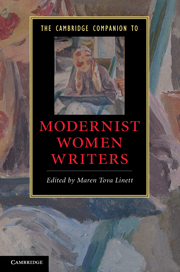Book contents
- Frontmatter
- Modernist women’s literature: an introduction
- 1 Transforming the novel
- 2 Modernist women poets and the problem of form
- 3 Women’s modernism and performance
- 4 Magazines, presses, and salons in women’s modernism
- 5 Gender in women’s modernism
- 6 Black women’s modernist literature
- 7 Race and ethnicity in white women’s modernist literature
- 8 Geomodernism, postcoloniality, and women’s writing
- 9 Women modernists and visual culture
- 10 Modernism and trauma
- 11 Political activism and women’s modernism
- 12 Religion and the occult in women’s modernism
- Guide to further reading
- Index
10 - Modernism and trauma
Published online by Cambridge University Press: 28 November 2010
- Frontmatter
- Modernist women’s literature: an introduction
- 1 Transforming the novel
- 2 Modernist women poets and the problem of form
- 3 Women’s modernism and performance
- 4 Magazines, presses, and salons in women’s modernism
- 5 Gender in women’s modernism
- 6 Black women’s modernist literature
- 7 Race and ethnicity in white women’s modernist literature
- 8 Geomodernism, postcoloniality, and women’s writing
- 9 Women modernists and visual culture
- 10 Modernism and trauma
- 11 Political activism and women’s modernism
- 12 Religion and the occult in women’s modernism
- Guide to further reading
- Index
Summary
The Greek word “trauma” literally refers to a physical wound and, until the last century, alluded strictly to bodily injury. As Jill Matus reminds us, both trauma and its iteration as combat fatigue syndrome, described in the twentieth century as post-traumatic stress disorder or PTSD, are “historically produced categories” whose foundations pre-date Freudian psychoanalysis in hypotheses formulated by nineteenth-century writers. A British military psychiatrist, Charles Samuel Myers, first coined the term “shell shock” in 1915, but it was not until the mid-1970s that therapists began to make “critical linkages between the trauma of war and the traumas of civilian life.” Contemporary theorists seem to agree on a definition of trauma in terms of overwhelming life experiences that shatter the social and psychological sense of self and precipitate existential crisis, characterized by “flashbacks, nightmares and other reexperiences, emotional numbing, depression, guilt, autonomic arousal, explosive violence or a tendency to hypervigilance.” The American Psychiatric Association, in the fourth edition of its Diagnostic and Statistical Manual of Mental Disorders, identifies the following symptoms: “recurrent and intrusive recollections of the [traumatic] event, . . . 'psychic numbing' or 'emotional anesthesia,'” and feelings of alienation characterized by a “markedly reduced ability to feel emotions.”
- Type
- Chapter
- Information
- The Cambridge Companion to Modernist Women Writers , pp. 160 - 171Publisher: Cambridge University PressPrint publication year: 2010
- 3
- Cited by



